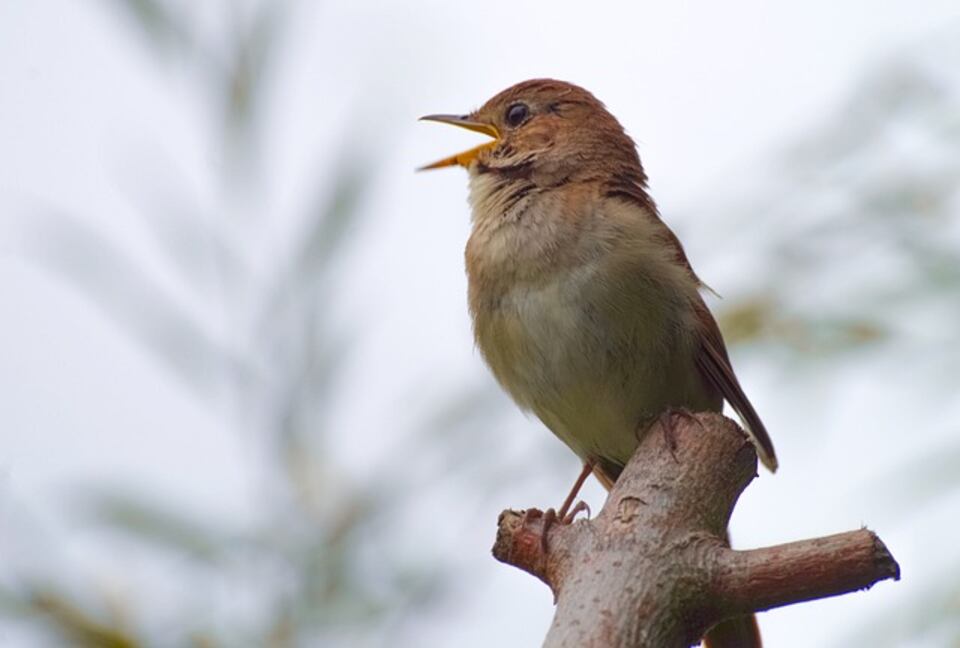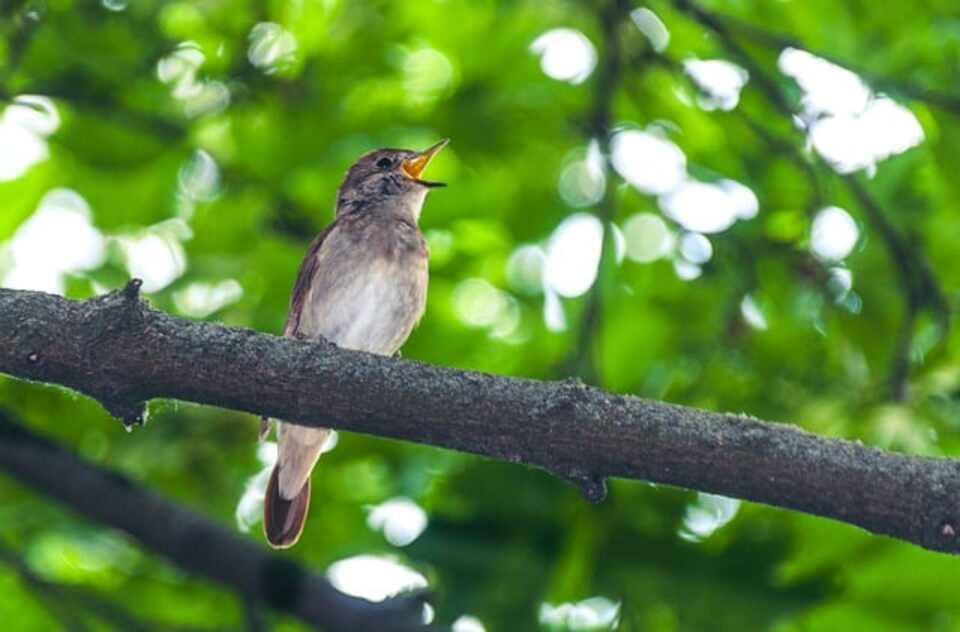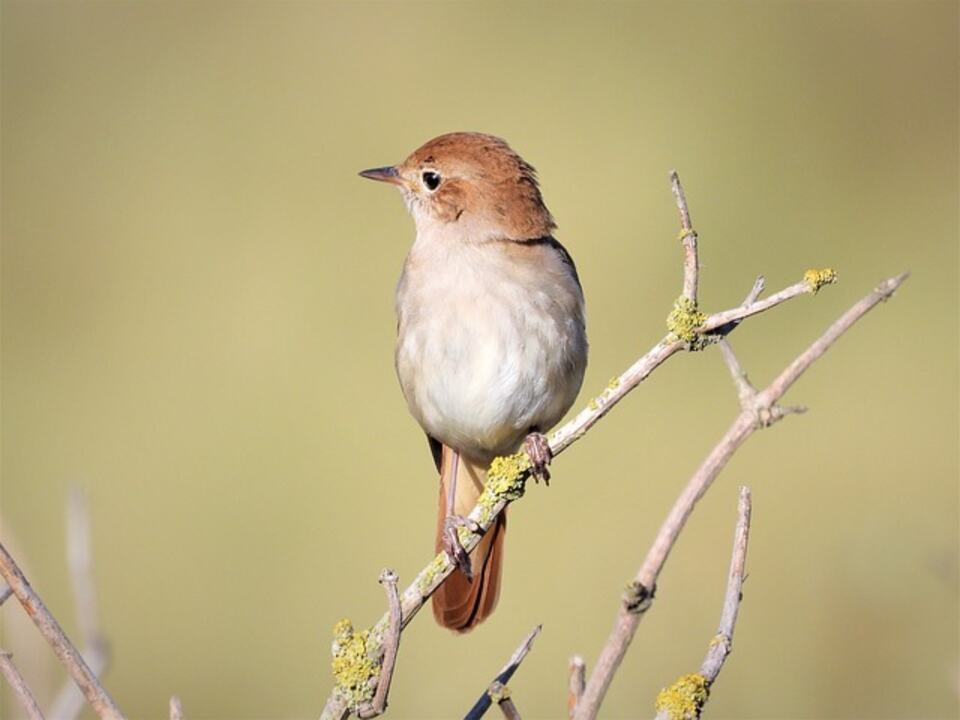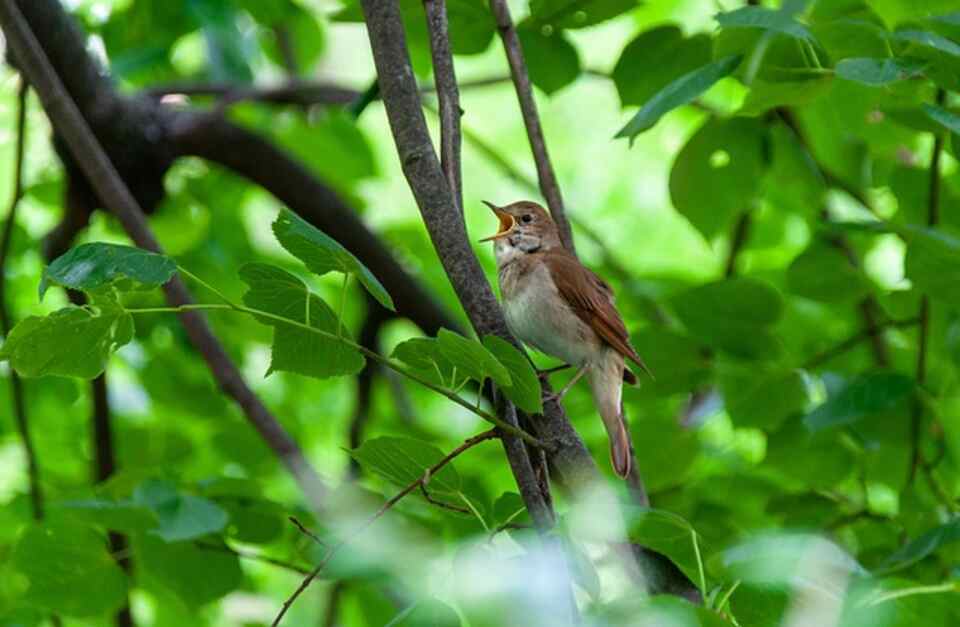You may have heard the phrase “sing like a nightingale,” but have you ever wondered why this little bird is so legendary? The Common Nightingale (Luscinia megarhynchos) is a master of song, filling the night air with melodies so rich and powerful that poets and musicians have celebrated it for centuries.
But there’s more to this bird than its voice. From its secretive nature to its fascinating migration, this guide dives deep into what makes the Common Nightingale truly extraordinary.
Table of Contents
- 1 Physical Characteristics: Beauty in Simplicity
- 2 Habitat and Distribution: A Bird of Two Continents
- 3 Vocalizations: The Nightingale’s Claim to Fame
- 4 Diet and Foraging Behavior: The Silent Hunter
- 5 Behavior and Social Structure: The Secretive Songster
- 6 Reproduction and Life Cycle: The Circle of Song
- 7 Conservation Status: Singing for Survival
- 8 Cultural Significance: The Muse of Poets and Musicians
- 9 Observing Nightingales: Tips for Enthusiasts
- 10 Conclusion: The Nightingale’s Enduring Song
- 11 Author
Physical Characteristics: Beauty in Simplicity
The Common Nightingale may not boast the flashy plumage of some other birds, but its understated appearance belies its extraordinary vocal abilities. Let’s examine the physical traits that define this remarkable songbird.
Plumage: Subtle Elegance
The Nightingale’s plumage is characterized by its modest brown coloration, which serves as excellent camouflage in its preferred habitats. Key features include:
- Overall color: Warm russet-brown on the upperparts
- Underparts: Lighter buff to off-white
- Tail: Reddish-brown, slightly darker than the body
- Wings: Brown, with a slight reddish tinge
- Face: Often features a pale eye-ring, enhancing its expressive look
This coloration allows the Nightingale to blend seamlessly with the undergrowth and leaf litter of its woodland habitats, providing crucial protection from predators.
Size and Shape: Compact and Agile
The Common Nightingale is a small bird with a robust build:
| Measurement | Range |
|---|---|
| Length | 15-16.5 cm (5.9-6.5 inches) |
| Wingspan | 20-23 cm (7.9-9.1 inches) |
| Weight | 18-27 g (0.63-0.95 oz) |
Its body shape is characterized by:
- A rounded head
- A relatively long tail
- Strong legs adapted for ground foraging
- A slender, pointed bill ideal for catching insects
Sexual Dimorphism: Subtle Differences
Male and female Nightingales are virtually identical in appearance, making visual sex determination challenging. However, there are some subtle differences:
- Males may be slightly larger on average
- During the breeding season, males can sometimes be identified by their singing behavior
Distinctive Features
While the Nightingale’s plumage may seem unremarkable at first glance, closer observation reveals some unique characteristics:
- Eyes: Large and expressive, dark brown in color
- Legs: Long and pale pinkish-brown, adapted for ground movement
- Posture: Often upright when perched, with tail slightly cocked
Habitat and Distribution: A Bird of Two Continents
The Common Nightingale is found across Europe, Central Asia, Asia minor, Middle East and Sub-Saharan Africa, with its range and habitat preferences shaped by its migratory nature and specific ecological needs.
Preferred Habitats
Nightingales thrive in a variety of woodland and scrub environments, including:
- Deciduous woodlands with dense undergrowth
- Riparian forests along rivers and streams
- Thick hedgerows and bushes
- Park edges with sufficient cover
- Overgrown gardens in rural and suburban areas
- Mediterranean maquis and garrigue habitats
Key habitat requirements include:
- Dense, low vegetation for nesting and foraging
- Open areas nearby for hunting insects
- Presence of leaf litter for ground feeding
- Access to water sources
Geographic Range
The Common Nightingale’s range spans:
- Most of Europe (except for the northernmost regions)
- Western Asia, including parts of Turkey and Iran
- North Africa, particularly during winter months
Migration Patterns
The Nightingale is a long-distance migrant, with fascinating migratory behaviors:
- Breeding grounds: Europe and western Asia
- Wintering grounds: Sub-Saharan Africa
- Migration timing:
- Spring migration: March to May
- Autumn migration: July to September
- Route: Follows a southeastern path across the Mediterranean and Sahara Desert
Factors influencing migration include:
- Day length (photoperiod)
- Weather conditions
- Food availability
- Innate genetic programming
Adaptations to Different Habitats
The Nightingale’s success across its range is due to several adaptations:
- Versatile diet: Able to feed on a variety of insects and small invertebrates
- Nocturnal activity: Allows for exploitation of night-time food resources
- Cryptic coloration: Provides camouflage in various woodland environments
- Strong flight capabilities: Enables long-distance migration
Vocalizations: The Nightingale’s Claim to Fame
The Common Nightingale is most famous for its rich, varied, and melodious song. This vocal prowess has made it a symbol of beautiful music across cultures and throughout history.
The Nightingale’s Song
The Nightingale’s song is characterized by its complexity, volume, and duration:
- Complexity: Estimated to have 250-260 different song types
- Volume: Can be heard up to a kilometer away
- Duration: Males can sing for hours, especially at night
- Timing: Most active during dawn and dusk, but also sings at night
Song Structure and Variations
The Nightingale’s song consists of a series of varied phrases, each lasting a few seconds. Key features include:
- Whistles: Clear, pure tones
- Trills: Rapid repetitions of a single note
- Gurgles: Liquid, bubbling sounds
- Clicks: Sharp, percussive notes
- Crescendos: Building up of volume and intensity
Functions of Vocalization
The Nightingale’s song serves multiple purposes:
- Territory establishment: Males use song to claim and defend breeding territories
- Mate attraction: Complex songs advertise male quality to potential mates
- Communication: Different calls for alarm, contact, and other social interactions
- Species recognition: Helps individuals identify others of their species
Seasonal and Daily Patterns
Singing behavior varies throughout the year and day:
- Breeding season: Most intense singing, especially by unpaired males
- Migration: Some singing occurs during stopovers
- Wintering grounds: Generally quiet, with occasional soft calls
Learning and Development
Nightingale song learning is a complex process:
- Critical period: Young birds learn songs during their first year
- Tutoring: Learn from adult males, often their fathers
- Practice: Spend months refining their songs before first breeding season
Diet and Foraging Behavior: The Silent Hunter
While renowned for its voice, the Common Nightingale is a silent and efficient hunter, primarily feeding on insects and other small invertebrates.
Main Food Sources
The Nightingale’s diet consists mainly of:
- Insects
- Beetles and their larvae
- Ants
- Flies and their larvae
- Moths and caterpillars
- Spiders
- Small worms
- Berries and fruits (especially during autumn migration)
Foraging Techniques
Nightingales employ several techniques to catch their prey:
- Ground foraging: Hopping and running along the ground, picking up visible insects
- Leaf litter searching: Using their bill to turn over leaves and find hidden prey
- Flycatching: Occasionally catching flying insects in short aerial pursuits
- Gleaning: Picking insects off leaves and branches
Adaptations for Foraging
The Nightingale has several adaptations that make it an effective forager:
- Bill shape: Slender and pointed, ideal for picking up small prey
- Eye size: Large eyes provide good vision in low light conditions
- Leg strength: Strong legs allow for quick movement on the ground
- Coloration: Brown plumage provides camouflage during foraging
Seasonal Diet Variations
The Nightingale’s diet can vary seasonally based on prey availability:
- Spring and Summer: Focus on protein-rich insects for breeding season
- Autumn: Increased consumption of berries and fruits to build fat reserves for migration
- Winter: Adapt to available food sources in African wintering grounds
Behavior and Social Structure: The Secretive Songster
Despite its powerful voice, the Common Nightingale is a surprisingly secretive bird, with fascinating behaviors and social structures.
General Behavior
Nightingales are known for their:
- Shyness: Often heard but rarely seen due to their secretive nature
- Nocturnal activity: Most active during dawn, dusk, and night
- Ground preference: Spend much time on or near the ground
- Territorial behavior: Strongly territorial during breeding season
Social Structure
The social structure of Nightingales is characterized by:
- Solitary nature: Generally solitary outside of breeding season
- Monogamous pairs: Form pair bonds during breeding season
- Territorial males: Defend breeding territories aggressively
- Loose flocks: May form loose associations during migration
Courtship Behavior
Nightingale courtship involves several behaviors:
- Male singing: Primary method of attracting females
- Territorial displays: Males chase intruders and perform flight displays
- Courtship feeding: Males may offer food to females during pair formation
- Nest site selection: Both partners may participate in choosing the nest site
Defensive Behaviors
When threatened, Nightingales may exhibit:
- Freezing: Remaining motionless to avoid detection
- Distraction displays: Feigning injury to lead predators away from nests
- Alarm calls: Sharp, repetitive calls to warn of danger
- Rapid flight: Quick, darting flight to escape predators
Reproduction and Life Cycle: The Circle of Song
The breeding biology of the Common Nightingale is as fascinating as its famous song. Let’s explore the journey from courtship to fledging.
Breeding Season
The timing of the breeding season varies across the Nightingale’s range:
- Western Europe: May to July
- Eastern Europe and Asia: April to June
- North Africa: March to May
Nest Building
Nightingales build their nests low to the ground:
- Location: In dense vegetation, often in brambles or low bushes
- Structure: Cup-shaped nest made of leaves, grass, and small twigs
- Lining: Soft materials like hair, fine grass, and rootlets
- Size: Typically 10-15 cm in diameter
Egg Laying and Incubation
The reproductive cycle involves:
- Clutch size: 4-5 eggs, occasionally 3-6
- Egg color: Olive-brown or blue-green, sometimes with darker speckles
- Incubation period: 13-14 days
- Incubation duty: Primarily by the female, with occasional male participation
Chick Rearing
The development of Nightingale chicks follows this general timeline:
- Hatching: Chicks hatch asynchronously over 1-2 days
- Nestling period: 10-12 days
- Feeding: Both parents feed the chicks, primarily with insects
- Fledging: Young leave the nest before they can fly well, continuing to be fed by parents
Post-Fledging Period
After leaving the nest, young Nightingales:
- Remain in cover near the nest for several days
- Are fed by parents for up to 2 weeks post-fledging
- Gradually develop foraging skills
- Prepare for their first migration at about 6-8 weeks old
Breeding Success and Challenges
Factors influencing breeding success include:
- Predation: Eggs and chicks are vulnerable to various predators
- Weather conditions: Cold, wet weather can reduce insect availability and chick survival
- Habitat quality: Adequate cover and food resources are crucial
- Human disturbance: Urbanization and agricultural practices can disrupt breeding
Conservation Status: Singing for Survival
While still relatively common in parts of its range, the Common Nightingale faces various conservation challenges.
Current Status
The International Union for Conservation of Nature (IUCN) lists the Common Nightingale as a species of “Least Concern” globally. However, population trends vary across its range.
Population Trends
- Western Europe: Declines observed in several countries, including the UK and Netherlands
- Eastern Europe: Generally stable populations
- Asia and Africa: Less well-studied, but some local declines reported
Threats
The Common Nightingale faces several threats:
- Habitat loss due to urbanization and agricultural intensification
- Climate change affecting migration patterns and breeding success
- Hunting during migration, especially in Mediterranean countries
- Pesticide use reducing insect prey availability
- Predation by domestic cats and other introduced predators
- Light pollution disrupting nocturnal behaviors
Conservation Efforts
Various measures are being taken to protect Nightingale populations:
- Habitat protection and restoration:
- Preservation of woodland and scrub habitats
- Creation of wildlife-friendly gardens and urban green spaces
- Research and monitoring:
- Population surveys and migration studies
- Investigation of the impacts of climate change
- Legal protection:
- Protected status in many European countries
- Regulations on hunting and capture
- Public awareness:
- Education programs about Nightingales and their habitats
- Citizen science projects to monitor populations
Success Stories
Conservation initiatives have shown some positive results:
- UK: Targeted habitat management in some areas has stabilized local populations
- Germany: Creation of “Nightingale-friendly” urban parks in Berlin
- France: Protection of key stopover sites along migration routes
Cultural Significance: The Muse of Poets and Musicians
The Common Nightingale has played a significant role in human culture, inspiring countless works of art, literature, and music across centuries and civilizations.
In Literature
The Nightingale has been a popular subject in literature:
- Ancient Greek and Roman poetry: Featured in works by Sappho and Ovid
- Medieval literature: Central to John Keats’ famous “Ode to a Nightingale”
- Fairy tales: Hans Christian Andersen’s “The Nightingale”
- Modern poetry: T.S. Eliot’s “The Waste Land” references the Nightingale
In Music
The bird’s song has inspired various musical works:
- Classical music: Featured in compositions by Beethoven, Tchaikovsky, and Stravinsky
- Folk music: Appears in traditional songs across Europe
- Contemporary music: Referenced in songs by modern artists across genres
In Folklore and Mythology
Nightingales feature in various cultural beliefs:
- Greek mythology: Associated with the story of Philomela
- Persian poetry: Symbolizes the lover in relation to the rose
- Chinese folklore: Represents fidelity and virtue
In Modern Culture
The Nightingale continues to inspire and appear in contemporary contexts:
- Conservation symbol: Often used to represent woodland bird conservation
- Artistic motif: Popular in decorative arts and design
- Scientific naming: Several organisms named after the Nightingale
Observing Nightingales: Tips for Enthusiasts
For those interested in observing Common Nightingales in the wild, here are some detailed tips and best practices:
When and Where to Look
- Timing:
- Best observed during spring and early summer in Europe
- Dawn and dusk are peak activity times, with night being optimal for hearing their song
- Habitat: Look for them in:
- Dense undergrowth in deciduous woodlands
- Thick hedgerows and scrubland
- Overgrown gardens and park edges
- Geographic hotspots:
- Southern England (e.g., Kent, Sussex)
- France (e.g., Loire Valley)
- Spain (e.g., Extremadura)
- Eastern Europe (e.g., Hungary, Romania)
Observation Techniques (continued)
- Auditory identification:
- Learn to recognize the Nightingale’s complex song
- Use smartphone apps or online resources to familiarize yourself with the calls
- Listen for the loud, clear notes and varied phrases, especially at night
- Visual identification:
- Look for movement in low vegetation
- Watch for a medium-sized brown bird with a slightly rufous tail
- Observe foraging behavior on the ground or in low branches
- Behavior to watch for:
- Singing from concealed perches
- Quick, darting movements between areas of cover
- Ground foraging in leaf litter
- Territorial disputes between males
Equipment and Preparation
- Binoculars: 8×42 or 10×42 magnification is ideal for most situations
- Field guide: A comprehensive guide covering European birds
- Audio recording device: To capture the Nightingale’s song (for personal use only)
- Flashlight or headlamp: For nighttime observation (use responsibly to avoid disturbing birds)
- Appropriate clothing: Quiet, comfortable attire suitable for sitting still for extended periods
- Insect repellent: As Nightingales prefer habitats that may also harbor mosquitoes
Ethical Birdwatching
- Respect the birds: Maintain a safe distance to avoid disturbing them, especially during breeding season
- Minimize disturbance: Avoid using playback of Nightingale songs, which can stress territorial males
- Follow local regulations: Adhere to protected area guidelines and private property rules
- Use artificial light responsibly: If observing at night, use red filters on flashlights to minimize disturbance
- Stay on designated paths: Avoid trampling vegetation or potential nesting sites
- Report sightings responsibly: Share observations with local bird organizations but be cautious about publicizing exact locations of rare or sensitive species
Joining Guided Tours
For those new to birdwatching or unfamiliar with Nightingale habitats, joining a guided tour can be beneficial:
- Expert guidance: Local guides often know the best spots for Nightingale sightings and can help with identification
- Educational opportunity: Learn about Nightingale behavior, ecology, and conservation from experienced naturalists
- Special access: Some tours may have permission to visit areas not open to the general public
- Equipment provision: Tours may provide high-quality binoculars or spotting scopes
- Conservation support: Many tours contribute to local conservation efforts
Conclusion: The Nightingale’s Enduring Song
The Common Nightingale, with its unassuming appearance and extraordinary voice, stands as a testament to the wonders of the natural world. From its complex vocalizations to its secretive behaviors, this small brown bird has captivated humans for millennia, inspiring art, literature, and scientific inquiry alike.
As we’ve explored in this comprehensive guide, the Nightingale is far more than just its famous song. Its migratory feats, adaptive behaviors, and ecological importance paint a picture of a remarkable species that plays a crucial role in its various habitats across Europe, Asia, and Africa.
However, like many species in our rapidly changing world, the Common Nightingale faces numerous challenges. Habitat loss, climate change, and other human-induced pressures threaten populations in various parts of its range. The decline of this iconic species in some areas serves as a poignant reminder of the broader issues facing our natural world.
Yet, there is hope. Conservation efforts, from habitat restoration to public education, are making a difference. The Nightingale’s ability to adapt to some human-modified landscapes, such as parks and gardens, offers opportunities for coexistence and conservation in an increasingly urbanized world.
For birdwatchers, nature enthusiasts, and conservationists, the Common Nightingale represents both a joy and a responsibility. The thrill of hearing a Nightingale’s song on a spring night is an experience that connects us deeply to the natural world. At the same time, ensuring that future generations can have this same experience requires ongoing commitment to conservation and sustainable practices.
As we conclude this exploration of the Common Nightingale, let us remember that each species, no matter how small or seemingly ordinary, plays a vital role in the tapestry of life on Earth. The Nightingale, with its breathtaking song and subtle beauty, reminds us of the poetry inherent in nature and the importance of preserving the diverse symphony of life that surrounds us.
Whether you’re a seasoned ornithologist, a casual birdwatcher, or someone who simply appreciates the beauty of nature, the story of the Common Nightingale offers something to marvel at and reflect upon. Its melody has echoed through our cultures and ecosystems for countless generations, and with proper care and stewardship, it can continue to enchant and inspire for many more to come.
So, the next time you find yourself in a wooded area on a spring evening, take a moment to listen. In the complex, melodious song that might reach your ears, you’ll hear not just the voice of a bird, but the voice of nature itself – a reminder of the beauty, resilience, and endless wonder of the world we share.






